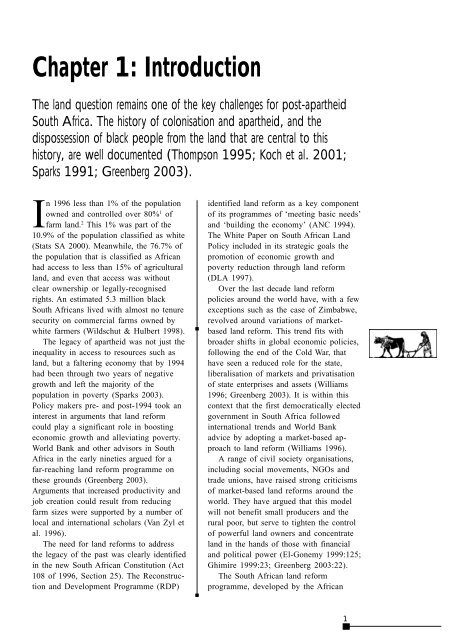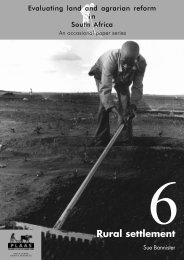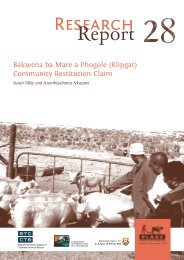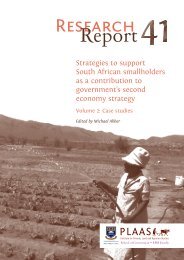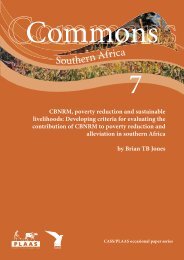A critical appraisal of South Africa's market-based land reform policy
A critical appraisal of South Africa's market-based land reform policy
A critical appraisal of South Africa's market-based land reform policy
Create successful ePaper yourself
Turn your PDF publications into a flip-book with our unique Google optimized e-Paper software.
Chapter 1: Introduction<br />
The <strong>land</strong> question remains one <strong>of</strong> the key challenges for post-apartheid<br />
<strong>South</strong> Africa. The history <strong>of</strong> colonisation and apartheid, and the<br />
dispossession <strong>of</strong> black people from the <strong>land</strong> that are central to this<br />
history, are well documented (Thompson 1995; Koch et al. 2001;<br />
Sparks 1991; Greenberg 2003).<br />
In 1996 less than 1% <strong>of</strong> the population<br />
owned and controlled over 80% 1 <strong>of</strong><br />
farm <strong>land</strong>. 2 This 1% was part <strong>of</strong> the<br />
10.9% <strong>of</strong> the population classified as white<br />
(Stats SA 2000). Meanwhile, the 76.7% <strong>of</strong><br />
the population that is classified as African<br />
had access to less than 15% <strong>of</strong> agricultural<br />
<strong>land</strong>, and even that access was without<br />
clear ownership or legally-recognised<br />
rights. An estimated 5.3 million black<br />
<strong>South</strong> Africans lived with almost no tenure<br />
security on commercial farms owned by<br />
white farmers (Wildschut & Hulbert 1998).<br />
The legacy <strong>of</strong> apartheid was not just the<br />
inequality in access to resources such as<br />
<strong>land</strong>, but a faltering economy that by 1994<br />
had been through two years <strong>of</strong> negative<br />
growth and left the majority <strong>of</strong> the<br />
population in poverty (Sparks 2003).<br />
Policy makers pre- and post-1994 took an<br />
interest in arguments that <strong>land</strong> <strong>reform</strong><br />
could play a significant role in boosting<br />
economic growth and alleviating poverty.<br />
World Bank and other advisors in <strong>South</strong><br />
Africa in the early nineties argued for a<br />
far-reaching <strong>land</strong> <strong>reform</strong> programme on<br />
these grounds (Greenberg 2003).<br />
Arguments that increased productivity and<br />
job creation could result from reducing<br />
farm sizes were supported by a number <strong>of</strong><br />
local and international scholars (Van Zyl et<br />
al. 1996).<br />
The need for <strong>land</strong> <strong>reform</strong>s to address<br />
the legacy <strong>of</strong> the past was clearly identified<br />
in the new <strong>South</strong> African Constitution (Act<br />
108 <strong>of</strong> 1996, Section 25). The Reconstruction<br />
and Development Programme (RDP)<br />
identified <strong>land</strong> <strong>reform</strong> as a key component<br />
<strong>of</strong> its programmes <strong>of</strong> ‘meeting basic needs’<br />
and ‘building the economy’ (ANC 1994).<br />
The White Paper on <strong>South</strong> African Land<br />
Policy included in its strategic goals the<br />
promotion <strong>of</strong> economic growth and<br />
poverty reduction through <strong>land</strong> <strong>reform</strong><br />
(DLA 1997).<br />
Over the last decade <strong>land</strong> <strong>reform</strong><br />
policies around the world have, with a few<br />
exceptions such as the case <strong>of</strong> Zimbabwe,<br />
revolved around variations <strong>of</strong> <strong>market</strong><strong>based</strong><br />
<strong>land</strong> <strong>reform</strong>. This trend fits with<br />
broader shifts in global economic policies,<br />
following the end <strong>of</strong> the Cold War, that<br />
have seen a reduced role for the state,<br />
liberalisation <strong>of</strong> <strong>market</strong>s and privatisation<br />
<strong>of</strong> state enterprises and assets (Williams<br />
1996; Greenberg 2003). It is within this<br />
context that the first democratically elected<br />
government in <strong>South</strong> Africa followed<br />
international trends and World Bank<br />
advice by adopting a <strong>market</strong>-<strong>based</strong> approach<br />
to <strong>land</strong> <strong>reform</strong> (Williams 1996).<br />
A range <strong>of</strong> civil society organisations,<br />
including social movements, NGOs and<br />
trade unions, have raised strong criticisms<br />
<strong>of</strong> <strong>market</strong>-<strong>based</strong> <strong>land</strong> <strong>reform</strong>s around the<br />
world. They have argued that this model<br />
will not benefit small producers and the<br />
rural poor, but serve to tighten the control<br />
<strong>of</strong> powerful <strong>land</strong> owners and concentrate<br />
<strong>land</strong> in the hands <strong>of</strong> those with financial<br />
and political power (El-Gonemy 1999:125;<br />
Ghimire 1999:23; Greenberg 2003:22).<br />
The <strong>South</strong> African <strong>land</strong> <strong>reform</strong><br />
programme, developed by the African<br />
1


